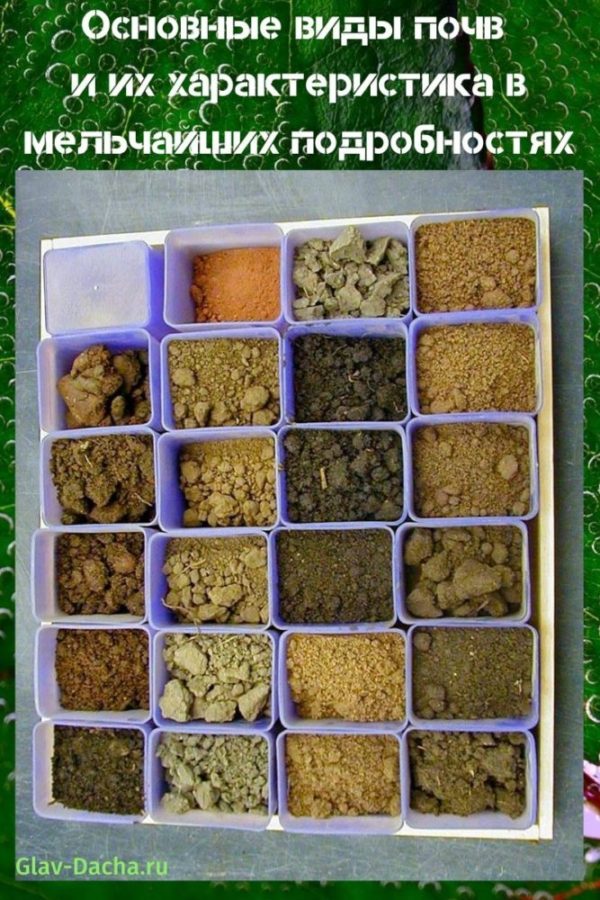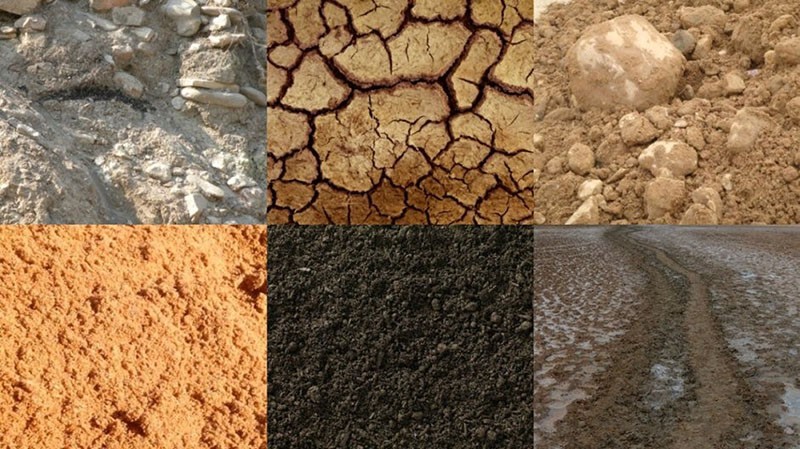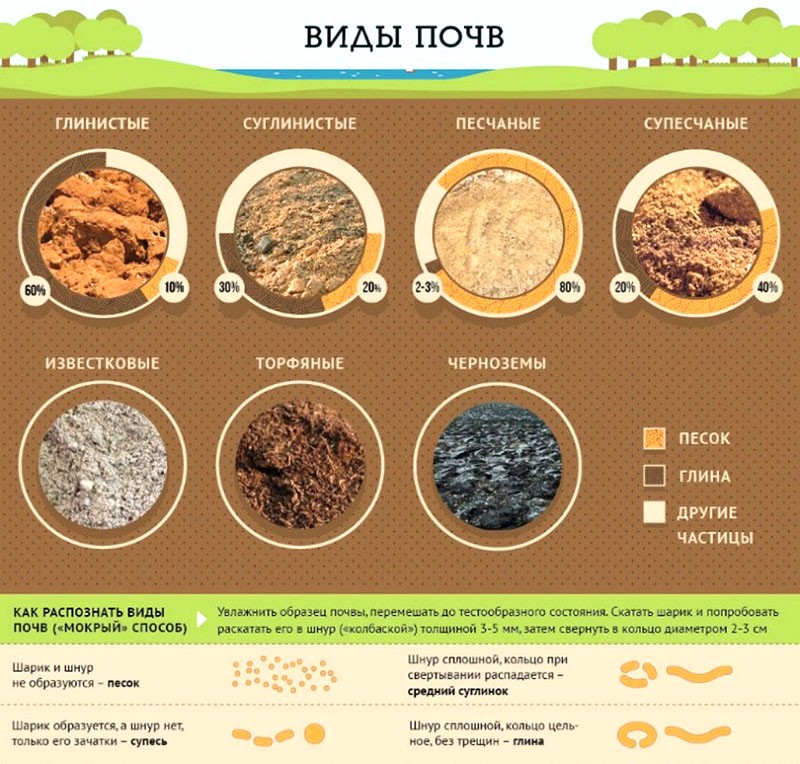The main types of soils and their characteristics in great detail
 Plants produce organic matter by combining carbon dioxide, nutrients and water from the soil. The types of soils and their characteristics show that the intensity of growth, development and productivity of crops grown depends on the composition of the garden land. Millions of bacteria are actively involved in the processing of organic and mineral particles, thereby ensuring the full functioning of this complex biological system. Therefore, soil breeds determine which varieties, agricultural techniques and fertilizers the farmer will choose.
Plants produce organic matter by combining carbon dioxide, nutrients and water from the soil. The types of soils and their characteristics show that the intensity of growth, development and productivity of crops grown depends on the composition of the garden land. Millions of bacteria are actively involved in the processing of organic and mineral particles, thereby ensuring the full functioning of this complex biological system. Therefore, soil breeds determine which varieties, agricultural techniques and fertilizers the farmer will choose.
Soil types and their characteristics in terms of mechanical composition


Sandstone
 Due to the high sand content (80%), sandy soils are classified as light types of soil. Good looseness and flowability provides excellent aeration as well as warming up. The earth quickly absorbs moisture and nutrients. At the same time, this is a disadvantage, because useful elements are not retained in the root system of plants and sink into the lower layers.
Due to the high sand content (80%), sandy soils are classified as light types of soil. Good looseness and flowability provides excellent aeration as well as warming up. The earth quickly absorbs moisture and nutrients. At the same time, this is a disadvantage, because useful elements are not retained in the root system of plants and sink into the lower layers.
The fertility of such areas is increased by introducing:
- peat;
- humus;
- clay;
- drill meal.
Sandstones have unique drainage properties. They perfectly filter water, as a result, the plants receive moisture without impurities.
 For each square meter, add up to 2 buckets of the listed compositions. In addition, mulching of the garden and embedding in the ground are successfully used. siderates... In other cases, at a depth of 30 cm, a fertile layer is created by laying a clay "pillow" (6 cm).
For each square meter, add up to 2 buckets of the listed compositions. In addition, mulching of the garden and embedding in the ground are successfully used. siderates... In other cases, at a depth of 30 cm, a fertile layer is created by laying a clay "pillow" (6 cm).
Nevertheless, sandstones grow ideally:
- fruit trees;
- Strawberry;
- carrot;
- melons;
- bow;
- currant.
Lupine is suitable as a green manure for sandy soil.
 This type of soil is also recommended for growing potatoes, peas, beets, tomatoes and cabbage, but only if fertilized regularly. The annual rate of use of compost / manure is 4 kg / m² with added lime (400 g). During spring processing, the embedment depth is 15 cm, in autumn - 20-25 cm.
This type of soil is also recommended for growing potatoes, peas, beets, tomatoes and cabbage, but only if fertilized regularly. The annual rate of use of compost / manure is 4 kg / m² with added lime (400 g). During spring processing, the embedment depth is 15 cm, in autumn - 20-25 cm.
Sandy loam
 Sandstones are related to sandy soils, which are also characterized by lightness, looseness, moisture and air permeability. However, they contain a higher percentage of clay (up to 20%). A photo of sandy loam soil shows that organic and mineral fertilizers, as well as water, are much better retained in it.
Sandstones are related to sandy soils, which are also characterized by lightness, looseness, moisture and air permeability. However, they contain a higher percentage of clay (up to 20%). A photo of sandy loam soil shows that organic and mineral fertilizers, as well as water, are much better retained in it.
For this reason, many types of garden crops grow on it, but especially:
- early and cauliflower;
- salads;
- celery;
- tomatoes;
- cucumbers.
A light substrate is quickly warmed up by the sun, therefore it is able to retain heat for a long time.
 Sandy loam is given viscosity with the help of peat and organic matter. It is compost / humus that serves as an important supplement for increasing fertility. Be sure to add wood ash when planting (in each hole). Together with it, a clay mixture is added in a ratio of 25 kg / m².
Sandy loam is given viscosity with the help of peat and organic matter. It is compost / humus that serves as an important supplement for increasing fertility. Be sure to add wood ash when planting (in each hole). Together with it, a clay mixture is added in a ratio of 25 kg / m².
Loam
 This is the most common soil type.It contains up to 30% clay and 20% sand. According to its properties, it is second only to black soil. The earth is characterized by its unique microflora. Due to the proper air and moisture permeability, the processes of decomposition and putrefaction are fully carried out in the substrate. Loamy soils are ideal for growing all cultivated plants.
This is the most common soil type.It contains up to 30% clay and 20% sand. According to its properties, it is second only to black soil. The earth is characterized by its unique microflora. Due to the proper air and moisture permeability, the processes of decomposition and putrefaction are fully carried out in the substrate. Loamy soils are ideal for growing all cultivated plants.
How to identify loam? A "roll" is formed from the moist earth and connected into a ring. If it breaks at the fold, then this is one of the most fertile soils.
Alumina
 Heavy soil contains up to 50% clay and sedimentary rocks (silt and other components). Therefore, it slowly absorbs moisture, air and heat. During precipitation, water stagnation forms on the surface. Because of this, plants develop late. Such areas are problematic to process, because when wet, the substrate sticks to the instruments, and when dry it has a high density and hardness.
Heavy soil contains up to 50% clay and sedimentary rocks (silt and other components). Therefore, it slowly absorbs moisture, air and heat. During precipitation, water stagnation forms on the surface. Because of this, plants develop late. Such areas are problematic to process, because when wet, the substrate sticks to the instruments, and when dry it has a high density and hardness.
A detailed characterization of clay soil will help to accurately determine it:
- coarse lumpy structure;
- high viscosity;
- low bandwidth.
Potatoes, beets, Jerusalem artichoke and peas are grown on heavy soil. Barberry, viburnum, hawthorn, currant and pear feel great in such a land.
As a standard, alumina is enriched with coarse sand (40 kg / m²) or ash, peat, lime. The activity of microflora is increased with the help of herbal compost or rotted manure.
Lime
 Lime soils also exist, depending on the composition. They are known for their high content of calcium carbonate (lime or chalk). These poor alkaline substrates quickly heat up and eventually dry out, leading to depletion of the grown crops. Due to the deficiency of iron and calcium, the foliage of plants turns yellow, and growth slows down.
Lime soils also exist, depending on the composition. They are known for their high content of calcium carbonate (lime or chalk). These poor alkaline substrates quickly heat up and eventually dry out, leading to depletion of the grown crops. Due to the deficiency of iron and calcium, the foliage of plants turns yellow, and growth slows down.
When processing limestone soil, the beds are loosened and watered as often as possible. Mineral potash fertilizers and organic matter are also introduced, which acidify the soil.
Peatlands
 The technical literature provides the following description of peat soil. The substrate perfectly retains mineral fertilizers, despite the fact that it contains a minimum amount of nutrients. Swampy soil is easy to cultivate.
The technical literature provides the following description of peat soil. The substrate perfectly retains mineral fertilizers, despite the fact that it contains a minimum amount of nutrients. Swampy soil is easy to cultivate.
Among the disadvantages of peatlands are:
- high acidity;
- poor surface heating;
- waterlogging ability.
Peat is ideal for growing shrubs: currants, gooseberries and mountain ash. Strawberries respond well to such formulations.
 To increase the fertile properties, sand is added together with clay flour. By adding manure, compost or microbiological additives, the soil characteristics are also significantly improved. Potash-phosphorus fertilizers play an important role in this “modernization”.
To increase the fertile properties, sand is added together with clay flour. By adding manure, compost or microbiological additives, the soil characteristics are also significantly improved. Potash-phosphorus fertilizers play an important role in this “modernization”.
When planting fruit trees on peat bogs, use a prepared soil mixture or apply the technology of bulk beds / hills (height up to 1 m).
Soil types and their characteristics in terms of organic composition
 As already noted, the types of soils and their characteristics are of organic composition. Due to the complex complex of chemical compounds, plants receive a sufficient amount of nutrients. Therefore, the yield of crops depends on the saturation of the soil with humus, vegetation, as well as the remains of the microfauna.
As already noted, the types of soils and their characteristics are of organic composition. Due to the complex complex of chemical compounds, plants receive a sufficient amount of nutrients. Therefore, the yield of crops depends on the saturation of the soil with humus, vegetation, as well as the remains of the microfauna.
Chernozems
 Answering the question of gardeners, which soils are especially rich in humus, they always call it black soil. Its fertility is due to the high content of humus (4-10%), as well as minerals.
Answering the question of gardeners, which soils are especially rich in humus, they always call it black soil. Its fertility is due to the high content of humus (4-10%), as well as minerals.
It includes:
- calcium (70%);
- phosphorus;
- magnesium (20%);
- ammonia;
- humic acids (15%);
- phosphorus compounds.
The main subspecies of chernozem are acidic, neutral and alkaline. Depending on the degree of salinity, there are common, carbonate and solonetzic types.
 The granular-lumpy structure allows the soil to retain moisture in the root space.Excellent looseness ensures proper oxygen circulation. Among other things, complex chemical reactions constantly take place in the deep layers of the earth, which provide the microflora with heat. Suitable for growing all cultivated plants.
The granular-lumpy structure allows the soil to retain moisture in the root space.Excellent looseness ensures proper oxygen circulation. Among other things, complex chemical reactions constantly take place in the deep layers of the earth, which provide the microflora with heat. Suitable for growing all cultivated plants.
Chernozem is determined by the bold black imprint that remains after the substrate is compressed in the palm of your hand. It is greasy to the touch with an oily sheen.
Like other soils, chernozem is susceptible to depletion, especially with constant use. In this case, organic fertilizers (humus, ash, compost) must be applied every 2-3 years. At the same time, it recommends sowing green manures annually on the site.
Serozem
 The main difference between these soils is their loose structure and light color. The upper tier has a high level of biological activity. Only 1 kg of earth contains about 10 billion unicellular microorganisms (bacteria, spores, actinomycetes). Especially in gray soils there are a lot of algae.
The main difference between these soils is their loose structure and light color. The upper tier has a high level of biological activity. Only 1 kg of earth contains about 10 billion unicellular microorganisms (bacteria, spores, actinomycetes). Especially in gray soils there are a lot of algae.
Also in the composition there is:
- humus (120-170 mm);
- turf;
- carbonate-illuvial compounds;
- silty loamy compositions;
- gypsum and readily soluble salts;
- deposits of potassium and phosphorus;
- nitrogenous substances.

To improve the quality characteristics of the soil, a crop rotation system of alfalfa and cotton is used. Mineral and organic complexes are also regularly introduced.
The gray soil type is used to grow crops such as cotton, wheat, rice, corn, beets and melons. In the process of processing gray soils, it is advised to irrigate the beds abundantly and of high quality. Such procedures are used to prevent salinization of land. In addition, farmers recommend forming a sufficiently deep arable layer.
Brown
 This variety will be the answer to the question of what kind of soil still exists in nature. Basically, these include forest soils, which can be presented in the form of loam, sandy loam or sand.
This variety will be the answer to the question of what kind of soil still exists in nature. Basically, these include forest soils, which can be presented in the form of loam, sandy loam or sand.
The soil composition is formed during the decomposition of deciduous litter:
- oaks;
- beeches;
- ash trees;
- cedars;
- conifers (spruce, fir);
- maples.
 These intermontane areas are rich in organic and mineral compounds. Brown forest soils are saturated with humus (from 16%) and are rich in fulvic acids. Typically, the acidity index of such substrates ranges from slightly acidic to acidic. In the process of biochemical reactions, the formation of a clay layer occurs. Yet they are poor in silty substances.
These intermontane areas are rich in organic and mineral compounds. Brown forest soils are saturated with humus (from 16%) and are rich in fulvic acids. Typically, the acidity index of such substrates ranges from slightly acidic to acidic. In the process of biochemical reactions, the formation of a clay layer occurs. Yet they are poor in silty substances.
Increasing fertility is carried out using:
- irrigation;
- reducing the degree of salinity;
- adjustment of wind erosion.
Brown lands serve as an excellent basis for the cultivation of industrial, fruit, melons, grains and vegetables.
 These are just some of the soil types and their characteristics. There are also other classifications of soil: tundra, podzolic, meadow, gray forest, solonetz and black soil. The varieties of soil horizons are classified depending on the territorial affiliation of the country.
These are just some of the soil types and their characteristics. There are also other classifications of soil: tundra, podzolic, meadow, gray forest, solonetz and black soil. The varieties of soil horizons are classified depending on the territorial affiliation of the country.